Comparison test: Kia Seltos vs MG Hector
The biggest question on anyone's mind who's considering either the slick Kia Seltos or the sizable MG Hector is probably not which one drives better, has the more comfortable interiors or even which one lets you go longer between visits to the fuel pump. It's probably which manufacturer to trust with their hard-earned money Kia and MG are brand new to the country after all.

Who are they? Well, the Kia Motors story began in South Korea in the early 1940s as a bicycle maker, and is now the second largest carmaker in South Korea after Hyundai, who incidentally owns about one-third of Kia now. MG Motors on the other hand has a rich British heritage going back to the 1920s and is currently wholly owned by SAIC Motors, the largest auto maker in China. Back to the present, both are adding to their list of customer touchpoints (for sales and service) in India, with Kia reportedly present at 265 locations and MG at 120, while the reliability of both SUVs remains to be seen. With that done with, let's get into which makes you feel like you've got your money's worth.
Styling
There's a sizable difference between the two, pun intended. The Seltos is underpinned by a Creta platform, with a 20mm stretch in wheelbase and is just slightly larger than one overall. It still pales in comparison to the nearly 14-inch longer Hector. Side by side, the Seltos looks more complete, more finished. It's got exquisite detailing, with the knurling on the polished aluminium finish of the grille, ice cube stacked fog lamps and kink in the windscreen line standing out.
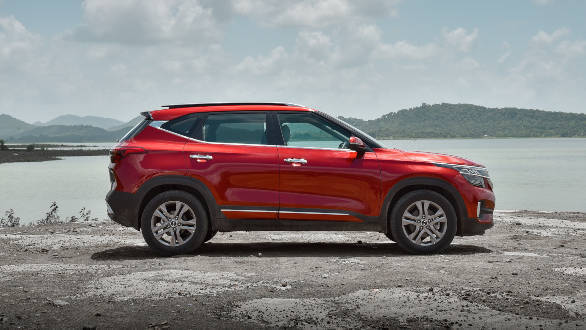
The Hector? It's got menacing looking DRLs where you would expect headlights, loads of chrome and a kink in the window line to set it apart. But ultimately, there's a huge difference in the height of the leading edge of the hoods of the two SUVs and the Hector has undeniable presence, even if its 17-inch wheels (the exact same wheel/tyre size as the Seltos) let it down in profile.
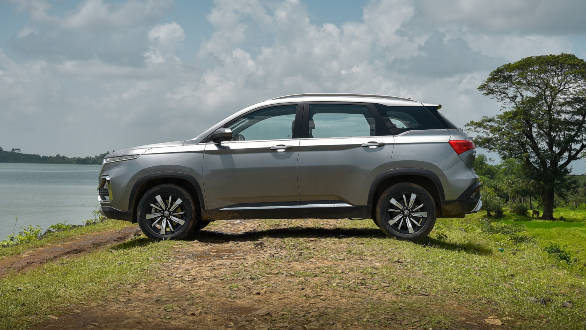
Around back, the Seltos' tail lights remind one of the Creta's, while the Hector draws up comparisons to those on German luxury SUVs. Personally, there's a bit too much chrome on either. But the Seltos' excess is better executed. The detailing in the lower bumper made to resemble exhaust cutouts is still less of an oddity than the Hector's lower bumper, for example. And while it's not like we didn't find panel gaps on the Seltos, the ones on the Hector seem more inconsistently spaced.
Interiors
The Seltos has the best cabin in the segment, hands down. There's precious little to find fault with the driving position is perfect (and quite car-like to the Hector's more SUV-like angled wheel positioning), visibility is great, the fit and finish is exemplary and the instrumentation is sporty and easy to read, the last two standing out against the Hector's okay-ish finish and reversed tachometer.
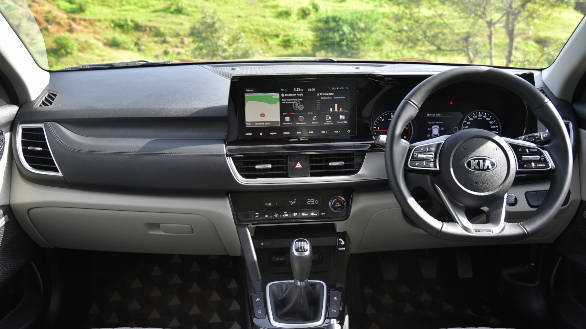
Some may find the Seltos' pedals a little too deep inside the footwell, though. Like the Hector, it's got a leather panel on the dash in this top-end HTX+ variant, with all the headline grabbing goodies too, with the exception of the head-up display, 360-degree camera and blind spot camera system which you only get on the turbo petrol GT Line top end. What that leaves you with is still a long list, minus automatic wipers.
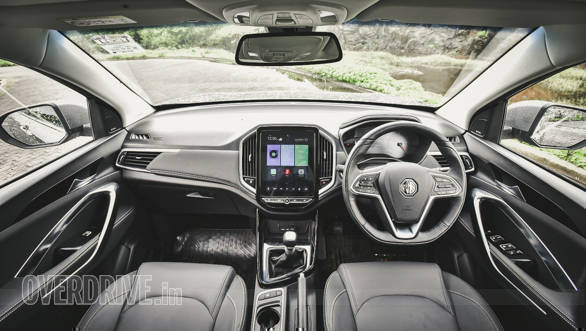
The Hector's dash layout is certainly unique and our first taste of what a Tesla is like, with the cabin designed around the infotainment screen. What that ends up leaving out is physical controls for the climate control and the Hector's on-screen controls are tough to use while driving (the Seltos has no such issue). Both get multiple choices for ambient lighting in the front of the cabin, with the Seltos' looking a bit classier in its implementation. Standouts here for the Seltos would be the ventilated seats and air-purification system, which also displays the air quality index inside the cabin; leave the windows open long enough and you can see the levels rise alarmingly.
There's not much separating the infotainment screens of both in size, the Seltos gets a 10.25-inch screen, the Hector a 10.4-inch one. But the Hector's tablet orientation is more impressive looking, even if the Seltos' split screen functionality means it's infinitely more useful, as well as being more responsive. The Seltos' is also easier to use when you're driving, with larger on-screen buttons but the home button is a stretch on the far side of the screen, presumably to be in reach of your co-passenger. Interestingly, with an 8-speaker audio system on both, the Hector's Infinity (by Harman) sound system is more detailed with better mids and highs than the Bose system on the Seltos. Both get connected car technology on board and voice recognition features, which can understand a more conversational tone of command, such as, 'I'm feeling cold', to increase the climate control temperature. The Seltos is more consistent, but hey, it still can't open the sunroof just by asking it to!

Which brings us to the massive panoramic sunroof with a powered blind, which in conjunction with the lower window line, makes the Hector's cabin feel massive even though it's a dark interior. Sat on the rear bench, you still have an entire head of open sky above you and that's something the Seltos can't match (with its single pane sunroof), as is the amount of legroom you have. The Hector would also be much better suited to three adults in the rear bench.
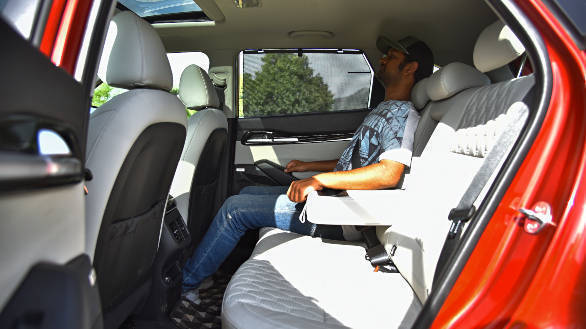
The seats themselves in both are equally comfortable. As for luggage carrying capacity, the Seltos' 433 litres is quite a bit short of the Hector's 587 litres. The Hector scores big time by having a powered tailgate with release buttons on the key fob, inside the car, and on the tailgate itself. Overall, the Seltos has perceived quality on its side, while the Hector impresses with sheer space.
Safety features
With six airbags, all four wheel disc brakes, front and rear parking sensors, a tyre pressure monitoring system and ISOFIX mounting points on both SUVs, the Hector starts to differentiate itself by offering traction control and an electronic stability program to help keep things under control. It also offers 3-point seat belts for all three passengers in the rear seat. We don't have Global or Euro NCAP ratings for either of these SUVs yet but the Hector's sibling in China, the Baojun 530, has earned a 5-star rating in the C-NCAP tests.
Engine, performance and efficiency
With the new 1.5-litre diesel in the Seltos, Kia easily has the most refined oil-burner in the country. It's also BSVI compliant already, in case you were wondering, and the Seltos sets the benchmark for refinement, even against the Hector, which arguably has the best NVH levels for the FCA-sourced 2-litre diesel, also in the Tata Harrier and Jeep Compass. The Kia's 115PS/250Nm figures maybe down on the 170PS/350Nm of the Hector but it's a smaller, lighter package so performance figures are within half of second of the larger-engined SUV. In-gear performance tells a similar story but what it doesn't reveal is how well the first two ratios have been spaced in the Seltos, making for an effortless drive in the city.

The Seltos' engine also has a very effective anti-stall feature which allows you to pick up from under 1,000 revs without judder, which means you can always find one gear to stick the Seltos in, in traffic. The Hector, on the other hand, had me shuffling between first and second in the fear of stalling it in traffic. The clutch in the Seltos has longer travel and is quite springy on the return, though it's not as heavy to depress as the Hector's, making the Seltos a better city driver for sure. Out on the open road, the Hector does seem to have a little more in the mid range for overtakes in top gear in the 80-120kmph zone. Running through the gears, the power feels like it comes in stronger on boost in the Hector but the Seltos has a pleasing punch to it as well. The Hector shifts through the gate with a reassuring feel and seems easier to find a lower gear from fifth than the Seltos which has a smooth shift but not enough distinction in its gates to be sure you've always got the right gear. Both post near identical fuel efficiency figures of around 15kmpl overall (75 per cent city, 25 per cent highway), which for the larger MG is quite good news indeed.

Ride and handling
Both these SUVs use MacPherson struts up front and torsion beams at the rear, with the Seltos tuned a little firmer for better body control and rebound damping, in comparison to the positively softly sprung Hector. Low speed ride is better on the Hector but only just and is offset by the Seltos' rock-steady composure at higher speeds. Even going over speed breakers, you'd be hard-pressed to tell the difference between the two but the Seltos does go into ruts or potholes a little noisier than the Hector. We haven't tested the Seltos with a full load yet but the Hector does well to retain its comfortable ride with five on board.
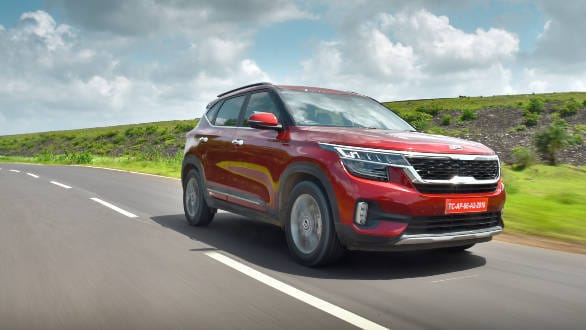
Where the Seltos can run circles around the Hector is when both come to a corner, with the Seltos sticking to its line confidently, with barely any body roll whereas the Hector will pitch into the corner. Both have electronically assisted steering systems, which feel over-assisted and lacking in real feedback at city speeds. But the Seltos' redeems itself by weighing up more progressively as the speeds rise, and when you turn into a corner. As for braking, the Hector stops a little shorter with a firm, consistent feel from the pedal, while the Seltos offers more scope for finer modulation of the brakes.

Verdict
The Seltos and the Hector rewrite the rules for the segment and seem to have pushed each manufacturer to put their best foot forward stepping into the country. That's a great thing for us, no? Especially when you consider the starting prices for both these SUVs. At the price of these fully-loaded variants, we think that the Seltos (which is essentially Creta-sized) is a harder sell but its sheer quality and sophistication is hard to ignore. Ultimately if it's space you want, the Hector is your best bet. As for us, the Seltos is good enough to make us question if we even really need all that space in an urban SUV.
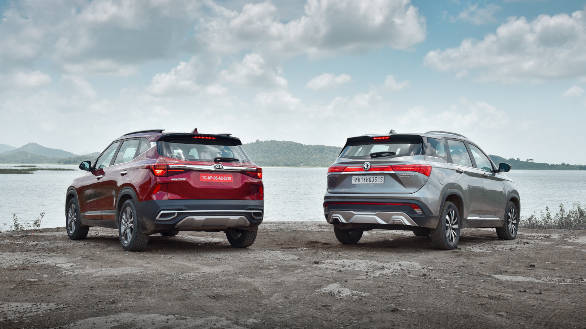
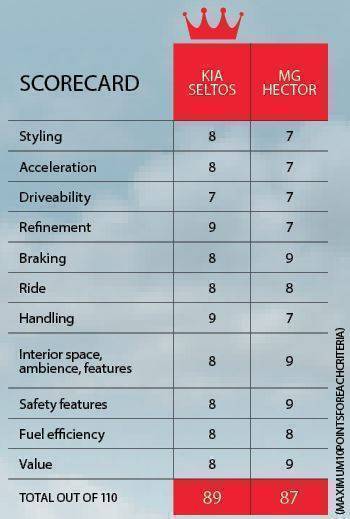
Also see: MG Hector vs Tata Harrier
Photography: Ram Shrikhande
Starts Rs 12.9 Lakhs
1496cc
Manual
143
250
15.8 Kmpl
Starts Rs 9.95 Lakhs
1497cc
Automatic
115
250
20.8 Kmpl
Starts Rs 17.79 Lakhs
1956cc
Automatic
163
350
14.9 Kmpl
-NA-
998cc
Manual
120
171.6
-NA-
Starts Rs 13.69 Lakhs
1956cc
Automatic
170
350
-NA-











